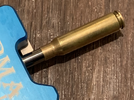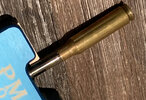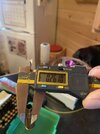The Glockodile
Member
- Joined
- May 6, 2020
- Messages
- 1,688
Reorganized all my old brass and came across a very special set - 100 pieces of Lapua .308 Winchester, fired 6 times - the very set that started me off with handloading so long ago.
Decided to pamper this set with a spa day.
1. Cleaned
2. Annealed with the Kiwi Device
3. Full Length Sized
4. Neck Dilated with a .307“ Carbide Expander Mandrel
5. Trimmed to 2.010,” verified neck thicknesses of 0.01450”

6. Checked necks for fit over a .306” Carbide Turning Mandrel - fit!…

7. Next morning, over the same .306" Turning Mandrel - surprise, no fit!!!
I DID account for case lip burrs as well as temperature, FWIW.
Never really thought to see this with Lapua brass.
On a similar anecdote - Ages ago, when I was still using a Tempilaq - guided Giraud… I’ve had CBC brass which was loaded the day before with neck tension that wasn‘t optimal but adequate, which ended up spilling powder all over the place as I grasped the tips to move them into some box. In this case, the “memory” sprung “the other way,” opposite to what the Lapua brass above did.
Is there any rhyme or reason to the way brass behaves, as far as this is concerned?
Decided to pamper this set with a spa day.
1. Cleaned
2. Annealed with the Kiwi Device
3. Full Length Sized
4. Neck Dilated with a .307“ Carbide Expander Mandrel
5. Trimmed to 2.010,” verified neck thicknesses of 0.01450”

6. Checked necks for fit over a .306” Carbide Turning Mandrel - fit!…

7. Next morning, over the same .306" Turning Mandrel - surprise, no fit!!!
I DID account for case lip burrs as well as temperature, FWIW.
Never really thought to see this with Lapua brass.
On a similar anecdote - Ages ago, when I was still using a Tempilaq - guided Giraud… I’ve had CBC brass which was loaded the day before with neck tension that wasn‘t optimal but adequate, which ended up spilling powder all over the place as I grasped the tips to move them into some box. In this case, the “memory” sprung “the other way,” opposite to what the Lapua brass above did.
Is there any rhyme or reason to the way brass behaves, as far as this is concerned?
Last edited:


